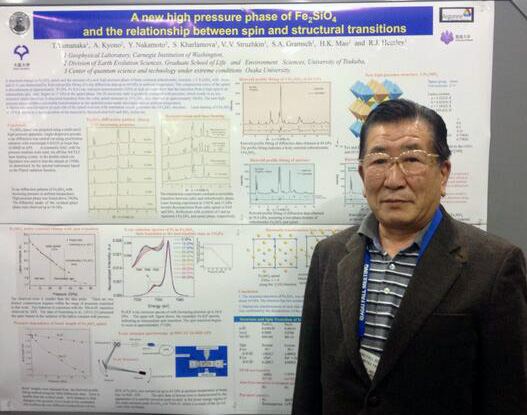Prof. Takamisu Yamanaka [Emeritus Professor of Osaka University, Japan]
Title: Magnetic and structure change at extreme conditions by neutron diffraction study in PLANET JPARC
Time: 10:00 - 11:00 AM, Thursday, May 18, 2017
Place: Auditorium Room 410, HPSTAR (Shanghai)
Host: Dr. Mao
Abstract:
Solid solution between Fe3O4 to Mn3O4 has been paid a large attention in geoscience and material science because of their magnetic and electronic properties. Further more they are the most fundamental ferrite in the industrial materials. Under extreme conditions, high-pressures and/or high temperatures, these properties or structure transformation are extreme significant subject to understand magnetic oxide materials. Mixed manganese ferrites having high Curie temperatures and magnetization depending on the composition form an important class of magnetic materials used in many technological application. These solid solutions have a ferrimagnetic property. The Currie temperature of many of them are higher than ambient temperature: Fe3O4 (858K), MnFe2O4 (563K) and Mn2FeO4 (413K) Mn3O4 (41.8K).
Neutron diffraction has an effective investigation for precise diffraction study of these solid solutions because of big difference in the scattering lengths. Mn has a negative coherent scattering length of -3.73fm, which is an extremely rare case in the all elements. On the other hand Fe has 9.54fm. By making use of this great advantage, we aim the following two TOF precise powder diffraction studies under high-pressures and high temperatures.
I. Currie temperature change as a function of pressure by powder diffraction.
1. Magnetic structure under high-pressure condition by diffraction pattern change.
2. Cation ordering or intra crystalline cation exchange.
II. Mn rich phases bearing Mn3+(3d4 with 3t2g 1eg) in the octahedral site often produce the lattice distortion by the Jahn-Teller effect. These phases have a tetragonal structure (I41/amd z=4) and have the elongated structure in the direction of the c axis with c/a>1. At ambient pressure Mn3O4 transforms from tetragonal to cubic structure at 1473K with dissolution of the Jahn-Teller effect. The following experiments using the sample of Mn3O4 and Mn2FeO4have been executed in PLANET JAPRC.
1. Pressure change of Jahn-Teller temperature.
2. Molecular orbital calculation of electron density distribution
III. By using PLANET facilities, neutron diffraction patterns are obtainable at wide PT condition, ranging from 0-20 GPa and 77 K-2000 K. To obtain clean pattern, the beam line is equipped with the incident slits and receiving collimators to eliminate parasitic scattering from the high-pressure cell. The high performance of the diffractometer with the resolution (d/d ~ 0.6%) and the accessible d-spacing range (0.2–8.4 Å) together with low-parasitic scattering characteristics enables precise structure determination of crystals under high-pressure and high-temperature conditions. 6-axses multi-anvil pressure apparatus ATSUHIME specially designed for high-pressure and high-temperature is also introduce in the seminar.
Biography of the Speaker:
 Prof. Takamitsu Yamanaka's experimental works have been focusing to X-ray diffraction, absorption and resonance using synchrotron radiation for 20 years in PF-KEK and SPring-8 in Japan. One of his science interests is crystal physics facing to electron-lattice and spin-lattice correlation in earth’s interiors under extreme conditions. His visit to the Lab aims at the improvement of high-pressure crystallography in Geophysical Laboratory.
Prof. Takamitsu Yamanaka's experimental works have been focusing to X-ray diffraction, absorption and resonance using synchrotron radiation for 20 years in PF-KEK and SPring-8 in Japan. One of his science interests is crystal physics facing to electron-lattice and spin-lattice correlation in earth’s interiors under extreme conditions. His visit to the Lab aims at the improvement of high-pressure crystallography in Geophysical Laboratory.
Takamitsu was a Professor in the Department of Earth and Space Science and Professor at the Center for Quantum Science and Technology under Extreme Conditions in Osaka University. He is Emeritus Professor of Osaka University. He is a Member of National Science Council of Japan belonging to Japanese cabinet since 2003. He is President of International Mineralogical Association (IMA). He in an active member of the organizing committee of International Union of Crystallography (IUCr-2008 at Osaka).
